class: center, middle # Introduction to Fyrnsidu #### by Byron Pendason --- class: middle ## What I Will Be Covering: In this presentation, I will be covering: - The meaning of the word *Fyrnsidu*. - What Fyrnsidu is. - A brief history of the Heathen Anglo-Saxons. - General beliefs, including cosmology, worship, and practice. - A brief walkthrough of a simple ritual suitable for beginners. - Where to find more information about Fyrnsidu. I will be describing my interpretation of Fyrnsidu in this presentation. It is not the only interpretation of Fyrnsidu, though I have tried to stick to what appears to be the general consensus among those who self-identify with Fyrnsidu. --- class: middle # Fyrnsidu .column2[  *Thunor's hammer, based upon a pendant found in Kent. Many Fyrnsideras use the Kentish Hammer as a symbol of their faith.* ] .column1[ **Fyrnsidu** is a *modern* religion based upon the pre-Christian spirituality of the Anglo-Saxons. It is a decentralised religion, meaning there is no religious authority in Fyrnsidu. It is very loosely organized, with most Fyrnsideras being either solitary practioners and/or belonging to non-Anglo-Saxon groups for their religious practice. ] --- class: middle # Etymology .column2[ 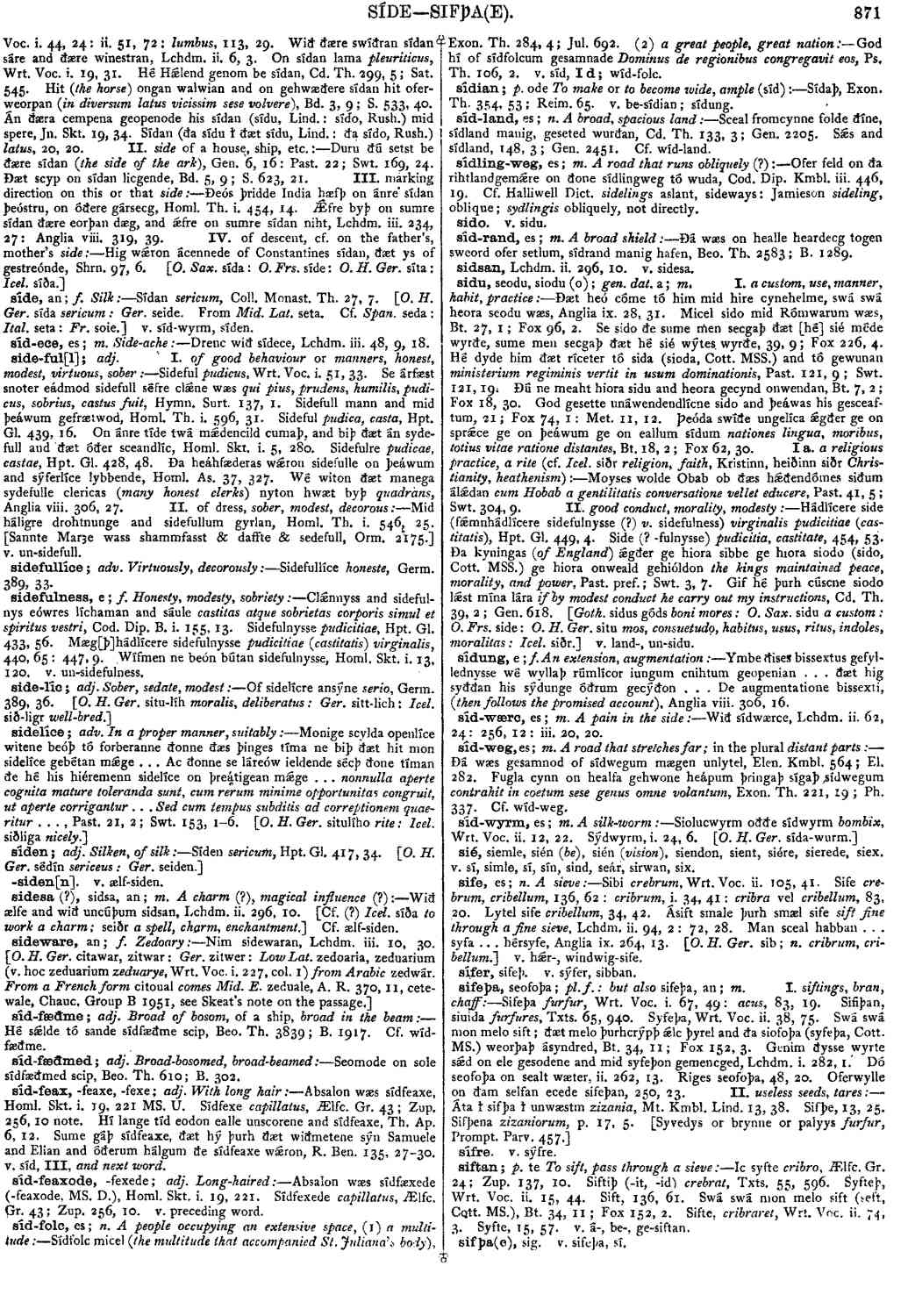 *A page from the Bosworth-Toller Old English Dictionary* ] .column1[ *Fyrnsidu* is a combination of two Old English words. - **fyrn** *Ancient, old* - **sidu** *A custom, use, manner, habit, practice* Source: Bosworth, Joseph. *An Anglo-Saxon Dictionary Online*, edited by Thomas Northcote Toller, Christ Sean, and Ondřej Tichy. Prague: Faculty of Arts, Charles University, 2014. <https://bosworthtoller.com>. ] --- class: middle # Fyrnsidu literally means *ancient custom* in Old English .column2[  *The Venerable Bede, an Anglo-Saxon Christian historian responsible for a lot of what we know about the Heathen Anglo-Saxons* ] .column1[ It is the Old English cognate of *Forn Sidr*, a name used by some Norse Heathens/pagans to identify their religion. Fyrnsidu is reconstructed from what we know about the spirituality of the pre-Christian Anglo-Saxons. A practioner is called a *Fyrnsidere* (plural: *Fyrnsideras*) or an *Anglo-Saxon Heathen/Pagan*. Some people (moreso in academic sources than elsewhere) prefer to call the Anglo-Saxons the *Old English*, but generally, the people are called *Anglo-Saxons* and the language they spoke is called *Old English* (which is ***not*** the same as Shakespeare's English or the language of the King James Bible. That is actually called *Early Modern English*.) ] --- class: middle # Who Were the Anglo-Saxons? .column2[ 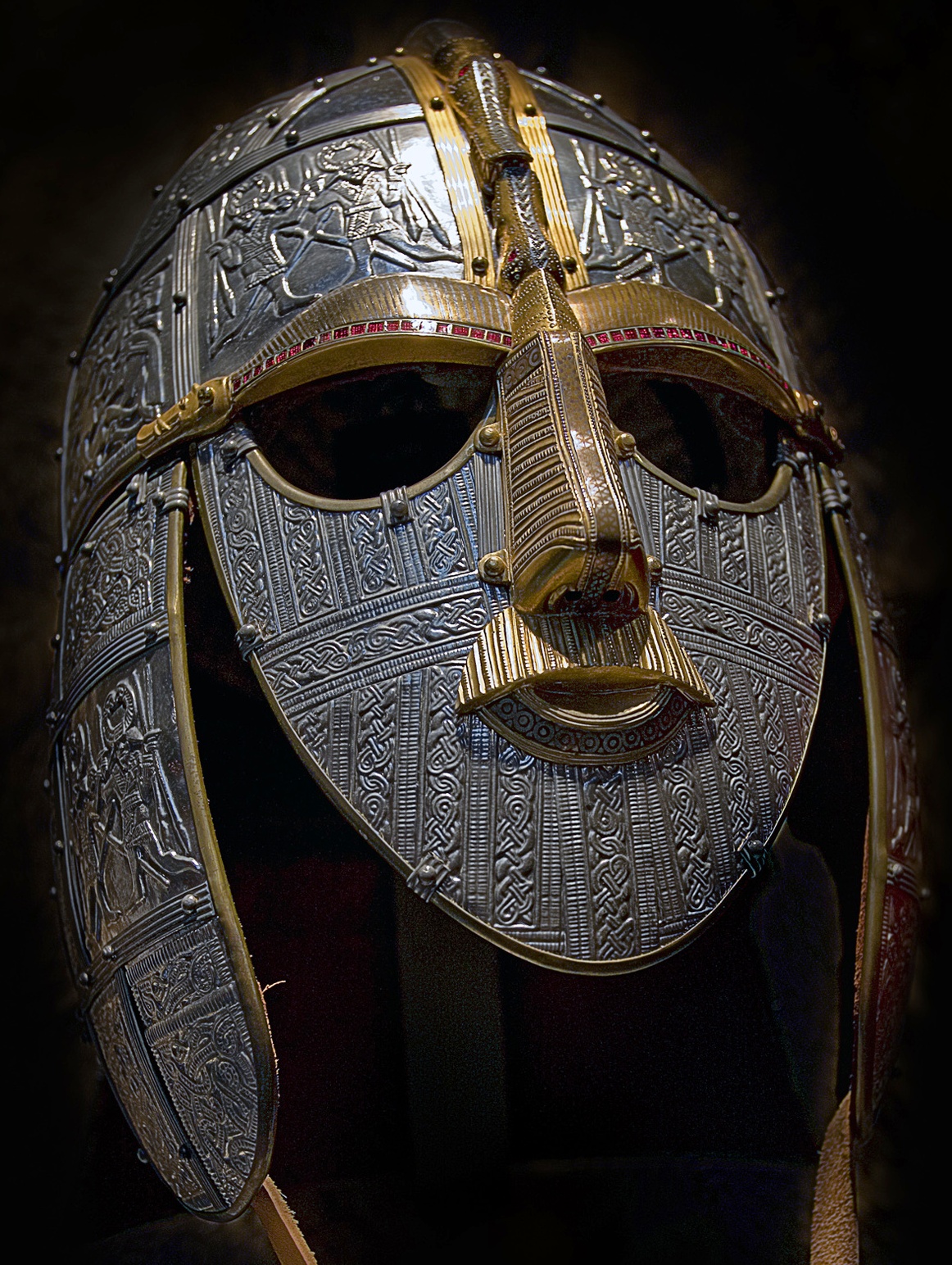 *The Sutton Hoo helmet* ] .column1[ The Anglo-Saxons were Germanic tribes who migrated to Britain after the Roman Empire abandoned Britain in the early to mid-fifth century CE. They established several kingdoms in Britain. The first of these kingdoms (Kent) was established by **Hengist** in 455 CE. The Anglo-Saxons brought a Germanic religion to Britain that was similar to that of the ancient Norse. This religion continued to be followed for about two centuries. ] --- class: middle # Conversion to Christianity .column2[  *Stained glass window depicting the death of Penda of Mercia* ] .column1[ The Gregorian Mission was established in 596 CE by Pope Gregory the Great. It was led by **Augustine of Canterbury** with the aim to convert the Anglo-Saxons to Christianity. **Æthelberht** was the first Anglo-Saxon king to convert in about 600 CE (the exact date is unknown). The rest of the Anglo-Saxon kingdoms converted in quick succession. This process was briefly stalled by **Penda of Mercia**, but his death in 655 CE is often seen as the death of Anglo-Saxon Heathenry in Britain. The last Heathen king of the Anglo-Saxons was **Arwald**, the last king of the Isle of Wight. He died in 686 CE in defense of his people when the Christian king of Wessex massacred the people of Wight. ] --- class: middle # Polytheism Fyrnsidu is a polytheistic religion. This means they believed in many gods. Many of the Anglo-Saxon gods are held in common with the Norse. These include: - Sunne (Sunna) - Mona (Mani) - Tiw (Tyr) - Woden (Odin) - Thunor/Thur (Thor) - Frig (Frigg) - Ing/Ingui (Yngvi-Freyr) - Baldæg (Baldur) - Hell (Hel) - Eorthe/Folde (Jord) The following gods do not have definite Norse counterparts: - Hrethe (victory goddess) - Eostre (dawn goddess) - Beowa (grain/barley god) - Seaxneat ("knife friend", possibly another name of Tiw) --- class: middle # Cosmology .column2[ 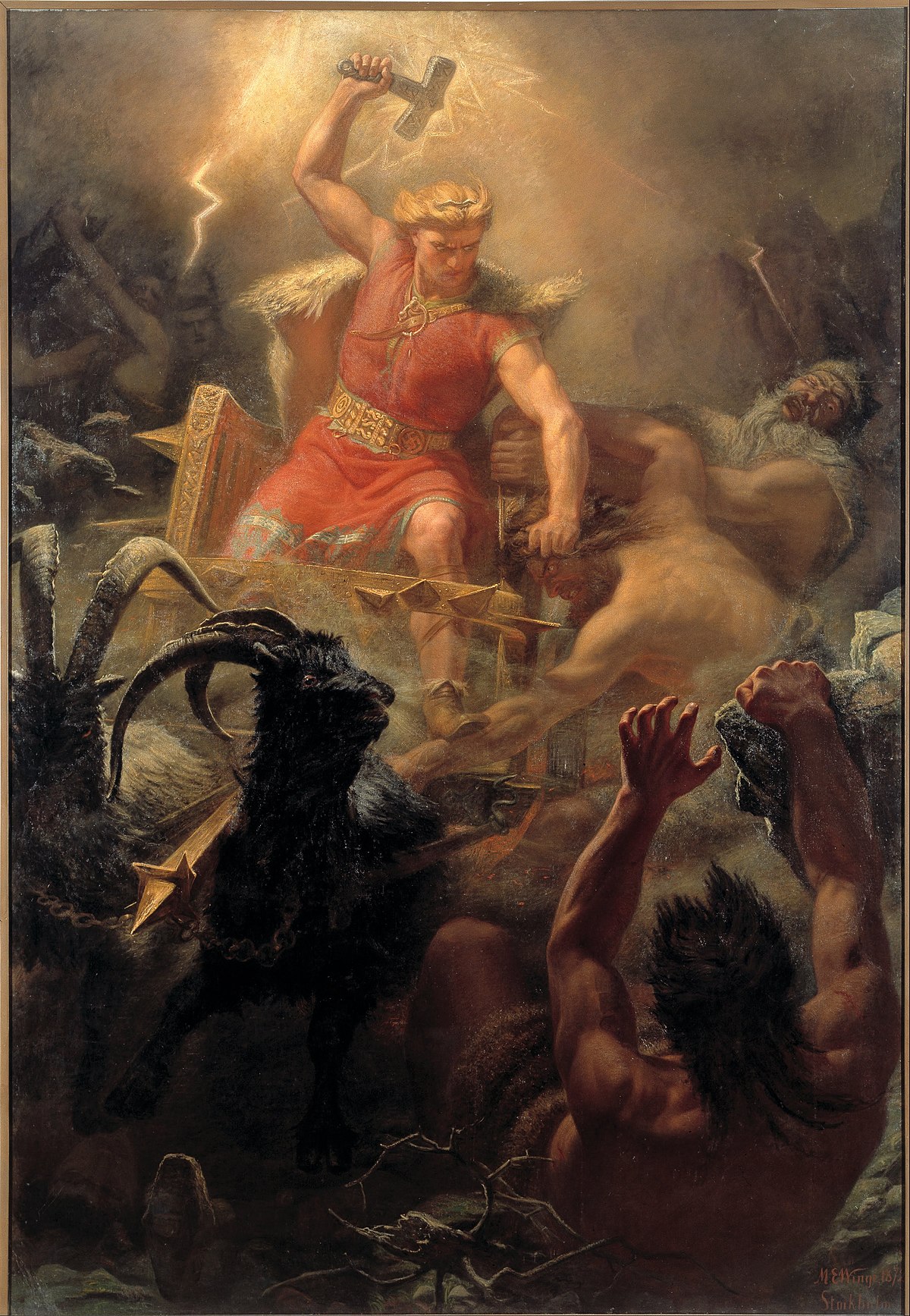 *The Thunderer battling ettins* ] .column1[ A *god* is a cosmic being that maintains the *cosmic order*. The universe was created when the gods brought order to the *cosmic chaos* that preceded everything else. *Ettins* (from the Old English word *eotenas*, generally translated as *giants* or *monsters*) are the cosmic beings that the gods descended from who oppose the cosmic order. Cosmic order and cosmic chaos is different from mundane order and chaos. Cosmic order is the balance of opposing forces that allows life to exist, thrive, and grow. Cosmic chaos is the state of the universe that preceded the cosmic order. It is generally interpreted as either a vast nothingness or as a formless mass of matter that had no shape or structure. ] --- class: middle # The Ancestors .column2[  *The Anglo-Saxons, dressed in typical clothing of the period* ] .column1[ In addition to the gods, Fyrnsideras also revere their ancestors and the wights who inhabit the world around us. *The ancestors* are the deceased who are responsible for a person being who they are. This includes one's biological ancestors as well as spiritual forbearers (the Heathen Anglo-Saxons of the pre-Christian era, for example). This could also include deceased mentors and historical figures that the practioner reveres. For people who were adopted, this also includes the ancestors of their adopted family. ] --- class: middle # The Wights .column2[ 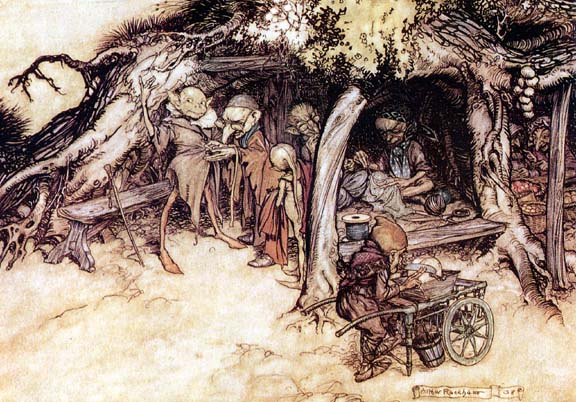 *Illustration of Shakespeare's "A Midsummer Night's Dream" by Arthur Rackham* ] .column1[ A *wiht* was a generic term in Old English for spirits or beings with a spirit (including humans). In the context of Fyrnsidu, though, it almost always refers to spirits who don't fit under the categories of *god*, *ettin*, or *ancestor*. There are both good wights and bad wights. As wight is a generic catch all term for spirits who aren't gods, ettins, or ancestors, most of these wights also have other terms that describe them. In the context of worship, a wight will usually be an elf. Elves are nature spirits who can be thought of as local deities of geographic regions and/or geologic features. Their scopes are much more limited than that of gods or ancestors. As nature spirits, they are generally neutral towards humans unless befriended or provoked. ] --- class: middle # The Gifting Cycle .column2[ 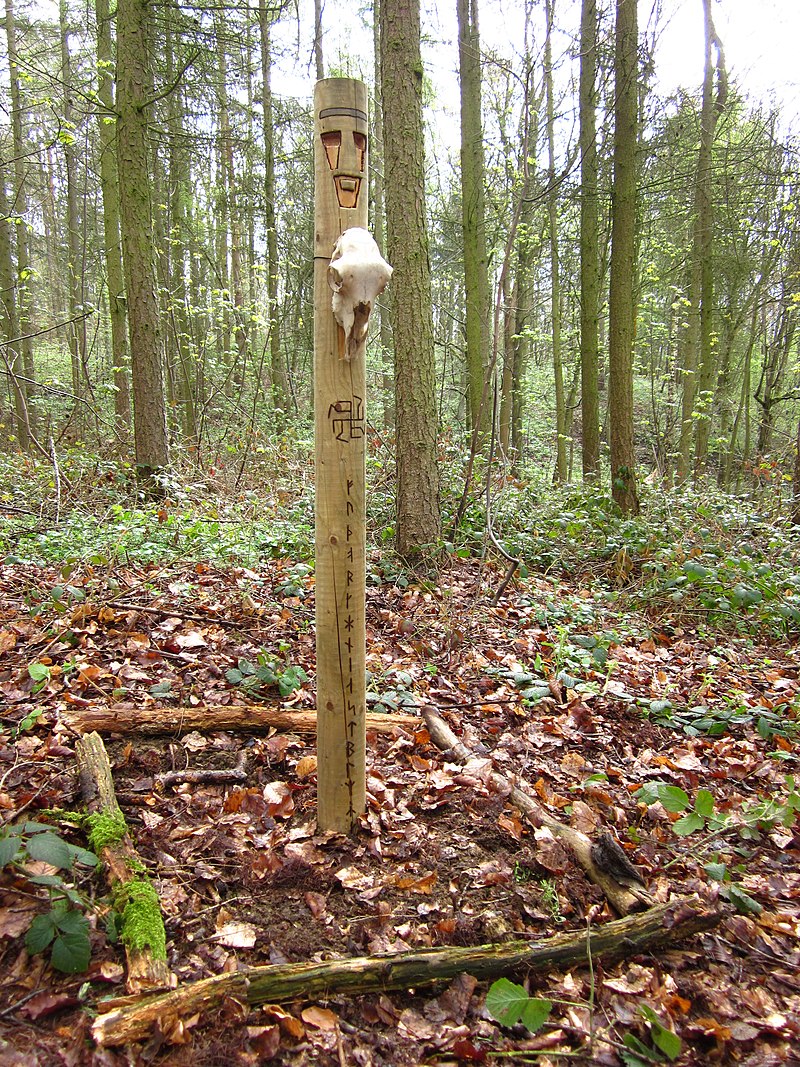 *Ritual space marked out by an engraved wooden pillar, located on The Wrekin in Shropshire, England* ] .column1[ The most common ritual in Fyrnsidu is *an offering* to one or more of the divine beings. This is how Fyrnsideras build relationships with the divine beings. A gift will usually be given in gratitude for blessings received or to ask for blessings. The practice of offerings is based upon the gifting cycle. Like most (if not all) of the pre-Christian religions of Europe, spirituality in Fyrnsidu is based upon reciprocity. A gift accepted demands a gift in return. The divine beings always have the option of refusing an offering, but if they accept a gift they will repay it with a gift of their own. Likewise, we should repay blessings from the divine beings with an offering to them. "A gift for a gift" is a common liturgical phrase in rituals in Fyrnsidu for this reason. ] --- class: middle # What to Offer .column2[ 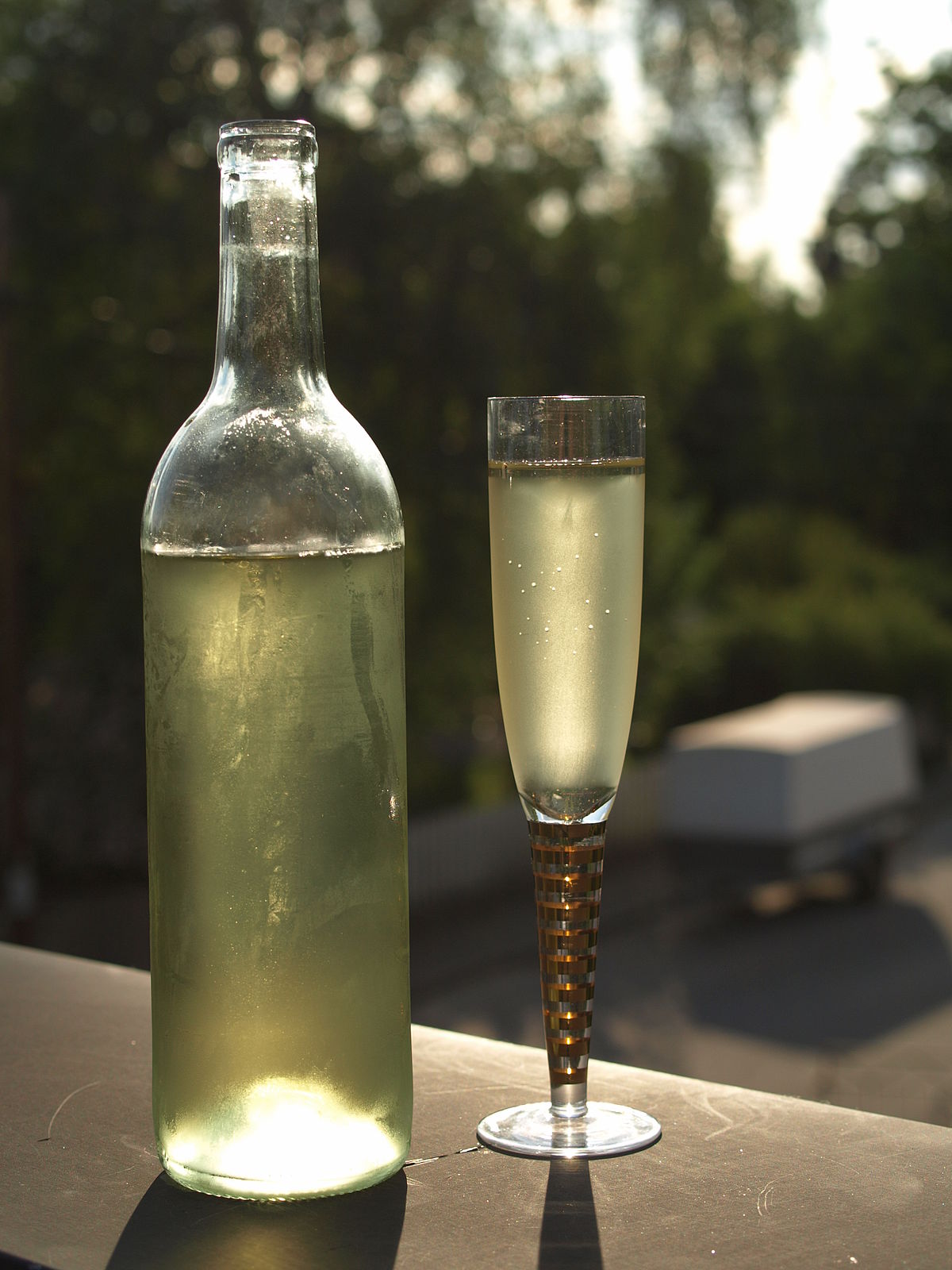 *Mead, a traditional Heathen offering* ] .column1[ Anything given respectfully and reverently can be an offering to a god. It's best to choose something that you associate with that god, but in a pinch even water will do. Common offerings include: - Incense - Mead/Beer/Ale - Food - Figurines Offerings can be disposed of in any fashion that you deem appropriate. The important thing is that it is removed from human usage afterwards. This can include throwing the offering away, burying it, burning it, throwing it in a river, etc. ] --- class: middle # The Parts of a Simple Offering The gifting cycle provides the *theory* behind offerings, but how do you make an offering? Let's go through [A Ritual of Thanksgiving](https://www.minewyrtruman.com/ritual_of_thanksgiving) from my website to demonstrate a simple offering. Offerings are made up of the following parts: - Cleansing - Hallowing - Introduction - Prayers - Conclusion Rituals in Fyrnsidu can get much more complex than this, but they almost always include these parts. --- class: middle # Cleansing As we go about our day to day lives, we gather spiritual pollutants. It's a sign of respect to ritually remove this uncleanliness before offerings. Most Fyrnsideras will wash their hands and face before a ritual, or take a bath/shower of they feel particularly unclean. I like to make the cleansing a part of my ritual. I'll have a bowl of salted water on my altar, and wash my face and hands at my altar, saying the following words: > May this water wash away all uncleanliness, making me presentable to the gods. --- class: middle # Hallowing We have made ourselves fitting to come before the gods, now it's time to do likewise with our altar space. On your altar, there should be a candle representing you hearth fire. Light this candle, and hold it above each cardinal direction of your altar, saying one line for each: > May the gods guide us! > May our oaths keep us! > May our deeds free us! > May our ancestors aid us always! Circle the candle around the altar three times, saying a line for each revolution: > May the gods banish from this place all ill and wrong, > Hallow this space, shield this area from all baneful wights. > Let the gods’ blessing be over our heads! --- class: middle # Ritual Introduction Now we express our intent for this ritual. Say these words: > I am forever indebted to the gods, for the many things they have blessed me and my loved ones with. I come before them today to express my gratitude. Though mere words will never be enough, it’s the least that I can do for them. > > I invite the gods to my humble altar today. May you feel welcomed here. --- class: middle # Prayers Now we get to the meat of the offering. Some Heathens prefer to kneel in front of their altar, others prefer to stand. Those who are unable to do either, may sit. Assume your prayer posture, and pray the following the lines: > Hail the *Ese*, the gods of my forbearers, > Who from the chaos brought forth order. > > Many are the blessings that you have bestowed upon me, > Far too many to ever list them all. > > I am extremely grateful for your generosity, > More than words could ever express. > Humbly I come before you today, > To express my gratitude the best that I am able. --- class: middle # Prayers (continued) Pick up your offering, and hold it above your altar: > I bring to you this gift, to thank you for all you have done, and all that you will do. Place the gift in your offering bowl, to be disposed of respectfully after the ritual. Conclude the prayer with the following: > A gift for a gift, may it be well received! Remain still for a few minutes, contemplating upon the gods and being open to receiving communication from them. You may add prayers of thanksgiving to individual deities here, if desired. --- class: middle # Concluding Your Ritual We have reached the end of our ritual. All that's left is to dismiss the gods. If kneeling or sitting, stand now if able. Dismiss the gods in a respectful manner. The following words may be used: > I thank you for your presence today. Until we meet again, may we part in peace. So may it be. --- class: middle # Offerings to Other Divine Beings Offerings to ancestors and wights are done in the same manner as when offering to gods. Offerings can be made to individual beings or to groups of them. Multiple offerings can be made in a single ritual. --- class: middle # Conclusion This was just a brief overview of Fyrnsidu, and a walkthrough of a simple offering. On the next slide, I will provide more resources for those who wish to learn more about Fyrnsidu. To summarise: - Fyrnsidu's cosmology is based upon the cosmic order, which the gods established by ordering the cosmic chaos that preceded the physical universe. - In addition to the gods, Fyrnsideras also revere their ancestors and nature wights. - Relationships with these divine beings are built through the gifting cycle, which is based upon reciprocity. --- class: middle # For More Information The best beginner's resource for Fyrnsidu is [Fyrnsidu.faith](https://fyrnsidu.faith/) website. In addition, there are several blogs that explore Fyrnsidu. These include: - *Wind in the Worldtree* https://windintheworldtree.wordpress.com/ - *Seolfor Cwylla Heorþ* https://seolforcwyllaheorth.wordpress.com/ - *Mine Wyrtruman* https://minewyrtruman.com/ - *Larhus Fyrnsida* https://larhusfyrnsida.com/ - *Of Axe and Plough* https://axeandplough.com/ There is also a Discord server dedicated to Fyrnsidu, which can be found at https://discord.gg/FcWzbeB, and a Facebook group which can be found at https://www.facebook.com/groups/Fyrnsidu/ --- class: center, middle ## Credits The Kentish Hammer on slide 3 was made by the author of [Wind in the Worldtree](https://windintheworldtree.wordpress.com/), and is used with permission. The scanned page from *An Anglo-Saxon Dictionary* on slide 4 came from [Bosworth-Toller Online](https://bosworthtoller.com/). All other images come from the various projects of the [Wikimedia Foundation](https://www.wikimedia.org/).